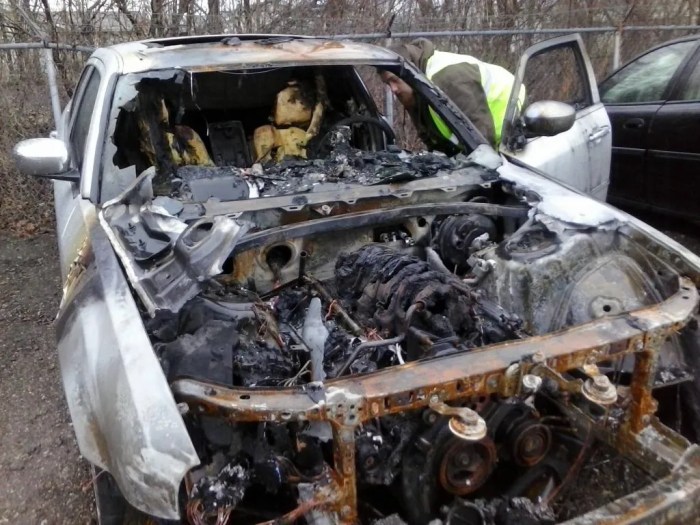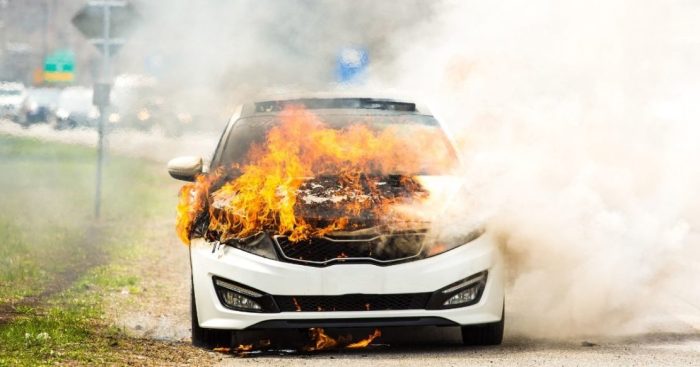Most vehicle fires start in the engine compartment, posing a significant threat to both vehicle occupants and property. Understanding the causes, implementing preventive measures, and utilizing effective fire detection and suppression systems are crucial for mitigating these risks. This article delves into the various aspects of engine compartment fires, providing valuable insights and practical guidance to enhance vehicle safety.
Most Vehicle Fires Start in the Engine Compartment

Engine compartment fires are a serious hazard, causing significant damage and even fatalities. Understanding the causes, prevention measures, and detection and suppression systems is crucial for mitigating these risks.
Engine Compartment Fire Causes
The leading causes of engine compartment fires include:
- Electrical malfunctions:Faulty wiring, loose connections, or damaged components can generate excessive heat, leading to ignition.
- Fuel leaks:Leaking fuel can come into contact with hot surfaces, such as the exhaust manifold, and ignite.
- Overheated components:Turbochargers, exhaust systems, and other components can overheat, causing nearby materials to catch fire.
According to the National Fire Protection Association (NFPA), electrical malfunctions account for approximately 45% of engine compartment fires, while fuel leaks contribute to 25%.
Fire Prevention Measures, Most vehicle fires start in the engine compartment
To prevent engine compartment fires, it is essential to:
- Perform regular maintenance:Regular inspections and tune-ups can identify and address potential fire hazards.
- Maintain proper fluid levels:Low fluid levels can lead to overheating and component failure.
- Avoid overloading the electrical system:Adding excessive electrical accessories or modifications can strain the system and cause fires.
- Use fire extinguishers and smoke detectors:Keep a fire extinguisher readily accessible in the vehicle and install a smoke detector in the engine compartment.
Fire Detection and Suppression Systems
Modern vehicles are equipped with various fire detection and suppression systems:
- Smoke detectors:Detect smoke particles in the engine compartment and trigger an alarm.
- Heat detectors:Monitor temperature and activate a fire suppression system when a certain threshold is exceeded.
- Fire suppression systems:Extinguish fires using water, foam, or dry chemicals.
These systems can effectively prevent or mitigate engine compartment fires, but regular testing and maintenance are crucial for their proper functioning.
Fire Damage Assessment and Repair
Assessing fire damage to an engine compartment involves:
- Visual inspection:Identifying burned components, melted wires, and other damage.
- Electrical testing:Checking for short circuits or damaged wiring.
- Mechanical inspection:Assessing the condition of the engine, transmission, and other mechanical components.
The extent of damage determines the necessary repairs, which can be costly and time-consuming.
Insurance Considerations
Insurance coverage is crucial for protecting against financial losses due to engine compartment fires:
- Comprehensive insurance:Covers fire damage regardless of fault.
- Collision insurance:Covers fire damage if the vehicle is involved in a collision.
- Insurance adjusters:Assess the damage and determine the compensation.
Adequate insurance coverage ensures peace of mind and financial protection in the event of an engine compartment fire.
FAQ Summary
What are the most common causes of engine compartment fires?
Electrical malfunctions, fuel leaks, and overheated components are the leading causes of engine compartment fires.
How can I prevent engine compartment fires?
Regular maintenance, proper fluid levels, and avoiding overloading the electrical system are effective preventive measures against engine compartment fires.
What types of fire detection and suppression systems are available for vehicles?
Smoke detectors, fire extinguishers, and automatic fire suppression systems are commonly used in vehicles to detect and suppress engine compartment fires.


